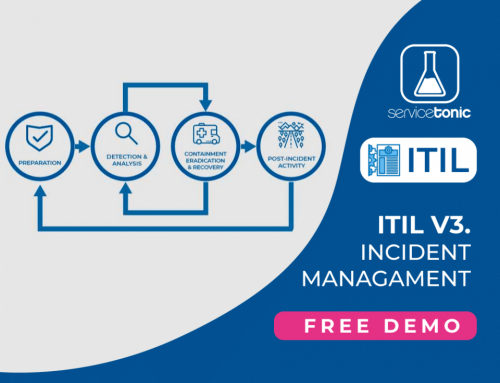Table of Contents
Things to keep in mind while selecting a Service Management tool and the associated process
A good Service Management tool is generally considered essential for success in the provision of services in an organization.
In this post, we will see some considerations to keep in mind during the associated selection process of an ITSM tool.
Benefits of Service Management tools
The Service Management tool helps us to provide faster, better service at a lower cost.
This is achieved through automation that lets us:
1. Increase productivity
The tool will perform some of the tasks associated with the Service without human intervention. Therefore, getting more work done with fewer people releases the workload of your employees, and lets them dedicate time to tasks that really provide value to the business.
2. Reduce Risk
The tool is not vulnerable to forgetfulness, misunderstandings, distraction, mistakes. This reduces the risk of failure in our service.On the other hand, the performance of individuals can vary depending on their knowledge, skills, experience, workload, health and motivation.
Instead, the automation ensures stability.
3. Collect and exploit large amounts of information on the Service
Over time the tool stores large amounts of data which enables:
– A real-time control of the service based on predefined indicators, allowing us to redirect unwanted situations before they become a problem.
– The detection of trends or patterns that can lead to the generation of opportunities for improvement, resulting once again in improving the quality of our service.
Before buying

Organizations often believe that their service problems will be solved by just buying a tool, forgetting that the success of the service still depends largely on the defined processes and the people who carry it out.
Before automatizing, it is very important to review the processes and try to simplify and eliminate errors/inefficiencies because if we automate erroneous processes we will only get crystallized forms of improper work.
Possible selection criteria
When selecting a tool, we should not limit our requests to its features.
Here is a list of possible requirements:
Functionality
We should obviously select the tool that is able to support our processes. The tools are available as standards while the requirements of each organization is different.Therefore, often it is required to tweak the tool to fit the requirements and these adjustments can occur in two ways:
– Configuration: functionality can be achieved by setting the tool’s parameters, without altering the underlying architecture of the software.
– Customization: Redesigning parts of the tool to provide expected functionality generally through code changes. Not only is this expensive, but also difficult to manage through the tool’s upgrade cycles in the future.
It is important that the software vendor validates that the changes we make are compatible with the new versions of the tool, otherwise we run the risk that the customized version of the tool soon becomes obsolete.
Flexibility / Versatility
Almost certainly, our service requirements will change over time.
A good tool can adapt to these changes via configuration without any programming. This will reduce cost and adhere to implementation deadlines.
Easy of use
An intuitive and easy to use tool will increase the productivity of agents and users, and reduce the learning curve.
Cost
Not all tools involve the same economic impact. An important criterion is the cost.
The cost usually comes from:
• Licenses
• Customization
• Implementation
• Training
• Support and maintenance
It is appropriate to consider all the above factors when estimating the cost of a tool.
Deadlines
The implementation timeline is important to consider when evaluating a tool. The Implementation duration is the time where we pay for the tool without actually being able to use it.
Normally, tools with big implementation timelines require a lot time during future upgrades.
Manufacturer independence
Once we have our tool implemeted, we might need to provide training to our end users or make ongoing changes to the tool to keep it updated with the business requirements. Depending on our needs and available resources, we can choose one of the following ways:
• To train our staff and only asking the provider for major changes.
• Hiring packs of service hours from the provider so they make any changes we need.
If you choose the first option, we have to ensure that:
• The tool is easily configurable.
• The provider offers training on the tool.
• The provider offers a support service in case of doubt.
Cloud or OnPremise
Depending on our needs we can opt for:
• Using the software provider’s infrastructure and hire the tool as a cloud service.
• Installing the tool on our internal infrastructure.
In either case, we have to ensure that the manufacturer provides the type we want.
Other requirements
Other aspects to consider when selecting a tool can be:
• The provider is the manufacturer. In this case, they have more autonomy to make decisions.
• Geographical proximity. Today the distance is salvageable thanks to technology but human contact and closeness is always a plus.
• Platform. Can we install the tool on our favorite platform?
• Licensing:
– Nominal vs Concurrent Licenses
– Purchase license vs rent
The selection process

1. Establish requirements
Once we are clear about how we will provide our Service and we have defined the associated processes, generate a list of all the classified requirements using the MOSCOW technique:
M – Must: essential requirements. We cannot function without them.
S – Should: Important requirements. Have a great impact; we must do everything possible to have them covered.
C – Could: Desirable requirements. We will have them if the impact is not very high.
W – Would: Future requirements. We do not need them now but we expect they will be necessary in the future.
2. Identify products
Identify potential candidates in the market by searching the web, references of colleagues, industry bulletins, etc. and discard those that do not comply a MUST.
3. Evaluate compliance requirements
Make a list of MUST and SHOULD requirements. Ask different providers if the requirements are met by configuring the tool or by customization. Always be sure to ask for the impact of customization.
4. Generate a short list of candidates
Based on the level of compliance with the various requirements, generate a list of 2 or 3 candidates.
5. Establish criteria
Establish a list of final criteria for the final evaluation. Make it easy assigning grades to the criteria.
6. Evaluate in detail
Ask the provider a test environment where to validate the tool and obtain information on the remaining selection criteria.
7. Assign grades
Assign a score to each tool using the grades of the different criteria and the level of compliance with the tool.
8. Select the tool to implement
Depending on the score and our instinct, we select the tool.
ServiceTonic and ITSM

In order to end this series on ITIL, let us briefly introduce ServiceTonic’s vision of IT Service Management.
ServiceTonic proposes a pragmatic view of the use of ITIL, adopting ITIL best practices to the characteristics of our customer: type of organization, process and users maturity in the service, available resources and budget and the time required.
The key word is sustainability.
At ServieTonic, we help companies implement ITIL processes they need so that their needs are met without exceeding their capabilities. – Manuel Molero, CTO ServiceTonic



